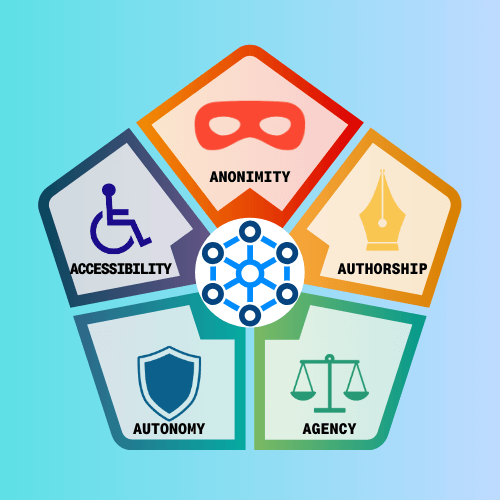
Digital Freedom Bill of Rights (Abridged)
Table of Contents
Digital Freedom Bill of Rights
Below is the abridged version of Digital Majority's penned "Digital Freedom Bill of Rights" ("DFBOR"). Our approach aims to balance the need for a comprehensive coverage of rights with a user-friendly, easy to remember, and practical approach such that the "silent majority" can find it helpful in utilizing the concepts in their daily digital use.
Each of the Article ties to one "A" of Digital Freedom - Anonymity, Autonomy, Authorship, Agency and Accessibility. It is then followed by the Social Contract of our Digital Economy - that users are expected a certain level of ethical responsibilities in exchange for receiving freedom and protection of the 5As. Finally, our vision is that the Digital Freedom Bill of Rights will create a harmonious digital future where global citizen can enjoy and ensure that their digital livelihoods are protected and enhanced, similar to the original U.S. Bill of Rights established over 235 years ago.

Digital Freedom Bill of Rights
Preamble
As the world becomes increasingly digital, these rights are foundational to ensuring individual freedom, creativity, and equity. They represent the guiding principles for a just and ethical digital future.
Core Rights
Right I: The Right to Anonymity
Every individual has the right to protect their identity, ensuring privacy and freedom from unwarranted surveillance.
Right II: The Right to Autonomy
Every individual has the right to control their personal data and actions, maintaining sovereignty over their digital presence.
Right III: The Right to Authorship
Every creator has the right to own and safeguard their intellectual property, protecting their contributions and benefiting from their work.
Right IV: The Right to Agency
Every individual has the right to access the tools, knowledge, and resources necessary to advocate for and defend their digital freedoms.
Right V: The Right to Accessibility
Every individual has the right to equitable access to technology and digital opportunities, fostering inclusion and fairness for all.
Framework of Responsibility
The Social Contract
Each individual and organization shares a responsibility to uphold the integrity of digital spaces. This involves acting ethically, respecting the rights of others, and contributing to a secure and equitable digital ecosystem.
The Ultimate Vision
The ultimate vision is a state of digital harmony—a balanced ecosystem where technology serves humanity equitably and transparently, empowering individuals from “zero to hero” to achieve their fullest potential without exploitation or harm.
FAQs
What is the Digital Freedom Bill of Rights?
The Digital Freedom Bill of Rights is a framework designed to protect fundamental digital rights in the modern age. It outlines five core rights—Anonymity, Autonomy, Authorship, Accessibility, and Agency—to empower individuals in an increasingly interconnected and digitized world.
Learn more about the Five Core Rights →
Why do we need a Digital Freedom Bill of Rights?
In today’s digital landscape, individuals face unprecedented challenges such as data exploitation, loss of privacy, and inequitable access to technology. The Digital Freedom Bill of Rights addresses these challenges by advocating for a fair, secure, and inclusive digital ecosystem.
Explore why these rights matter →
What are the five core rights?
1. Anonymity: The right to protect your identity and privacy online.
2. Autonomy: The right to control your personal data and actions.
3. Authorship: The right to own and protect your creative work.
4. Accessibility: The right to equitable access to technology and digital spaces.
5. Agency: The right to tools and knowledge to advocate for your digital freedom.
Deep dive into the core rights →
How does this compare to other digital rights frameworks?
The Digital Freedom Bill of Rights builds on established frameworks like the US AI Bill of Rights, EDRi’s vision for digital justice, and the Universal Declaration of Human Rights. While it shares common values like privacy and equity, it stands out by offering a simplified, actionable framework that emphasizes empowerment and individual agency.
See a detailed comparison →
What tools and resources can I use to protect my rights?
Here are some recommended tools to safeguard your digital freedom:
• For Anonymity: ProtonVPN, Signal
• For Autonomy: Jumbo Privacy, Cookie blockers
• For Authorship: Blockchain-based attribution systems, watermarking tools
• For Accessibility: Digital literacy programs, Municipal broadband initiatives
Explore our complete toolkit →
How do the Social Contract and Zero to Hero vision fit into this framework?
The Social Contract represents our collective responsibility to create ethical, secure, and inclusive digital spaces. The Zero to Hero vision is a long-term goal of achieving digital harmony, where individuals are empowered, technology is ethical, and everyone has equitable access.
Read more about our shared responsibility →
Who can benefit from the Digital Freedom Bill of Rights?
The framework is designed for:
• Individuals: Protect your data, creativity, and online identity.
• Organizations: Implement ethical data practices and inclusive technology.
• Policymakers: Advocate for digital rights legislation and equitable access.
Discover how these rights empower different groups →
What is the connection between the Digital Freedom Bill of Rights and Digital Majority?
The Digital Majority initiative simplifies complex digital challenges into approachable frameworks, like the Digital Freedom Bill of Rights. By making these concepts accessible, it aims to empower the marginal minority to advocate for and embrace their digital rights, turning them into a majority voice for change.
Learn about Digital Majority’s mission →
How can I get involved in promoting digital freedom?
• Educate yourself: Download our Digital Freedom Starter Pack.
• Join the conversation: Participate in our community forums and webinars.
• Take action: Use digital rights tools, advocate for ethical technology, and share your story.
Join the movement →